First-year identification: as straightforward as suggested?
In early November 2004, in a one-week period, three ficedula flycatchers (either Red-breasted F. parva or Red-throated/Taiga Flycatcher F. albicilla) were found and photographed by NM on Socheong island in far north-west South Korea.
All showed dark blackish-brown longest uppertail coverts (fringed obviously paler), contrasting with a black upperside to the central rectrices - a feature generally believed diagnostic of Red-breasted Flycatcher, an extra-limital species found well to the west of the region, being claimed only once before in Korea (in April 2003).
A selection of photographs that NM took of these three birds (Individuals 1, 2 and 3) are posted and discussed below, and compared with images of more typical albicilla in Korea and a parva banded in the UK.
Using existing criteria published in e.g. Cederroth, Johansson and Svensson, 1999 and on their calls (see below), it appears that both Individuals 1 and 2 are identifiable as parva. The third individual, however, is not so certainly identified, appearing much closer to albicilla in having colder upperparts, an apparently paler throat, and a markedly less obviously pale bill-base – but also paler longest uppertail-coverts than retrices (thus as parva). Hybrids between the two taxa are thought to exist - could this individual have been one of them?
Or more simply, is the coloration of the uppertail coverts perhaps a more variable feature than presently thought?
The seminal paper in Birding World by Cederroth, Johansson and Svensson (1999), on these two taxa proposes several key identification features for separating albicilla from parva in the field.
Simplified, in first year birds these include (all quotations direct from BW):
A largely all-dark bill in albicilla (with young having a similar bill to adults, or a "more extensive paler reddish-brown base…still darker than in parva".
Generally colder greyer tones to the plumage of albicilla: "Females and first winter albicilla have a rather clean whiteish throat (with few exceptions), and are dull, grayish tinged dusky-brown on the flanks, with a variable but mostly faint warm buff tinge. In contrast, parva is warmer and paler colour beneath….without a contrastingly white throat. However, some albicilla are slightly paler and a little warmer below than most…"
"In all plumages, the longest uppertail coverts of albicilla are invariably blackish or black (finely tipped brown when fresh) and are darker than the tail, whereas in parva they are generally medium brown or dull, dark grey-brown, concolorous with or paler than the tail. Only rarely does parva show blackish-brown or blackish uppertail coverts".
Differences in the tertials, albicilla showing more distinct, paler fringes along the outer web, and parva showing smaller more rounded or wedge-shaped tips and darker fringes".
A different facial expression (parva looking comparatively "weak" and "innocent") and size impression (albicilla appearing a touch larger).
In addition, based on personal field experience of parva in western Europe, and rather more experience of albicilla in eastern Asia (in months between November and May, from 1990 to the present, in countries from Thailand north to China, South Korea and Japan), and from the excellent plates produced in Birding World, it can be suggested that albicilla often appears to:
have a slightly deeper blunter-looking bill;
have rather sturdier legs and feet, with perhaps a much longer central toe (this appears clearly visible in plate 6 of the Birding World article and in image 2 below: is this typical?)
feed more on or near to the ground (or tends to, at least on migration and in non-breeding areas) rather than in the canopy like many parva. Is this a good indicator of albicilla too, or does parva also often feed by hopping thrush-like on the ground, picking out items from the leaf litter?
Though not applicable to a set of photographs, the calls of the two taxa sound different too: to our ears albicilla’s call is harder and drier - differences also noted in a mail sent by Atle Ivar Olsen.
The rattle calls of the two taxa are also different: albicilla’s call is noticeably harder and drier. "..it’s worth emphasising how different the calls of parva and albicilla are. I had the benefit of comparing them side by side in India and once I realised how consistent the difference was I could confidently identify them on voice alone. The calls of albicilla sound deeper to me, and its wren-like "trrrr" rattle is drier-sounding, since the individual ticks it’s composed of are much closer together than parva’s: in two examples I compared, the interval between the ticks the rattle is composed of is 58 millisec in parva but only 20 millisec in albicilla. No doubt other calls differ too, though I only heard single ticks and rattles from albicilla on the trip...."(Magnus Robb, in lit. 2003)
1st Winter Red-throated Flycatchers: South Korea, October 2001
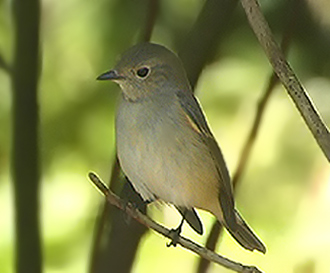
October 2001, Gageo Do © Charlie Moores
This bird shows many of the features described by Cederroth et al: the overall tones are largely grayish and cold, the bill is clearly largely dark, and the throat is whiteish.
In addition, this bird shows a strong yellow-buff flush on the lower breast sides and a small but striking, isolated yellowish-white patch on the outermost edge of the greater primary or marginal coverts, creating an impression vaguely suggestive of American Redstart Setophaga ruticilla.
Suggested also by one (?) parva specimen in Birding World plate 8 is this a feature also shown regularly/occasionally by parva? Is it present on all first years of both species, with the contrast simply increased in the colder-looking albicilla?
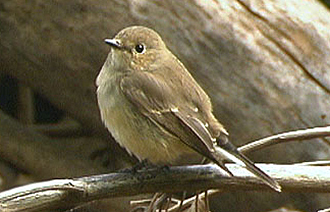
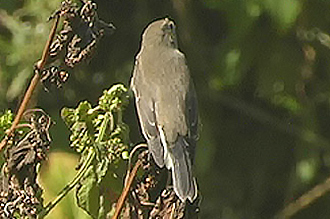
Two images of the same individual Red-throated Flycatcher from Korea, one from the side and one from the rear, show the blackish longest uppertail coverts usually considered diagnostic of albicilla.
1st winter Red-breasted Flycatcher: UK, October 1998.
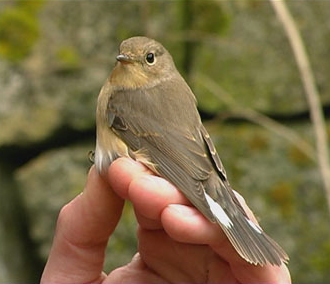
October 1998. © Charlie Moores
In this image, the generally very warm underparts and upperparts colouration is striking; the eye-ring appears buffish-tinged, the forehead warm-coloured, and the throat clean and warm orangey. The paler bill colouration especially on the bill base is also apparent, as is perhaps the bill shape (slightly finer-looking and sharper than albicilla?). Clearly too, the tertial patterning described by Cederroth et al is spot on for parva. Although there is a pale edge to the closed forewing, this is less contrasting than often shown by albicilla.The longest uppertail coverts are brownish-black, perhaps only slightly paler than the tail.
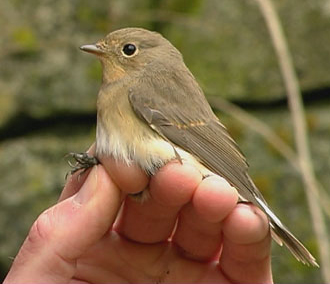
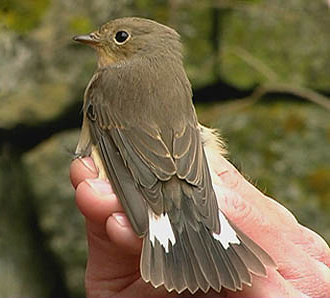
1st winter Red-breasted Flycatchers: South Korea, November 06 and 11, 2004
The images of Individual 1 and Individual 2 clearly reveal several of the features considered diagnostic in the separation of Red-breasted from Red-throated, most especially an orangey-base to the bill and blackish, brown-edged lower uppertail coverts clearly paler than the darker tail (rather than the all jet-black uppertail coverts of the much colder plumaged Red-throated Flycatcher).
It also showed a perhaps subtly different structure to both individuals 1 and 2, having a rather heavier-looking bill (an effect only of it being darker?), perhaps longer legs and toes, and a more upright, deeper-bellied, rather aggressive looking posture (in some ways suggestive of Eurasian Robin Erithacus rubecula). The overall feel of this individual was therefore much closer to albicilla than parva.
If correctly identified, these are the second and third Red-breasted Flycatchers recorded in South Korea, following one on Eocheong in spring 2003 (go to Latest Birds April 2003 for a photograph). The species has been photographed several times in neighboring Japan.

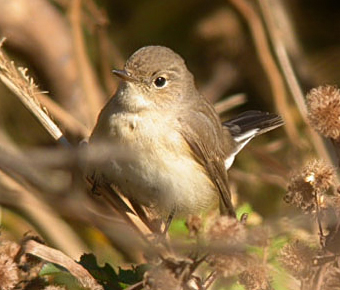
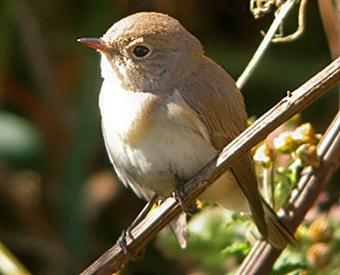
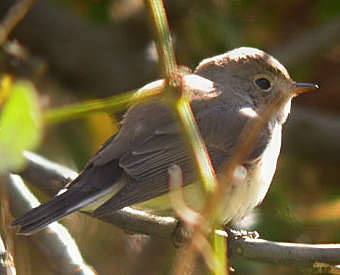
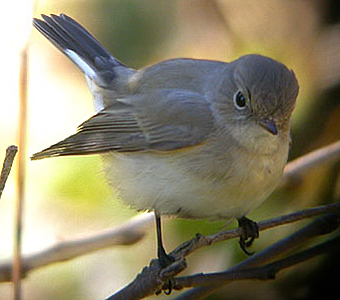
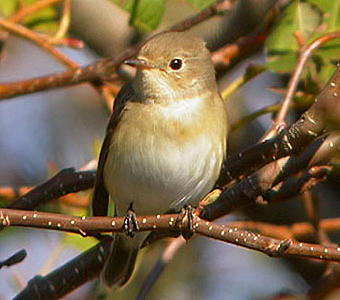
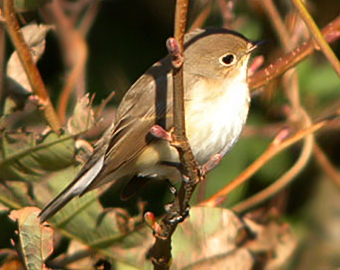
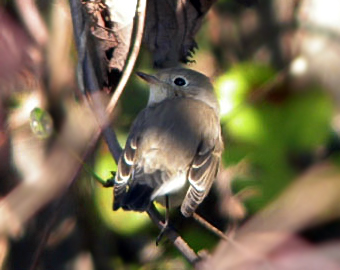
The two images of Individual 3, as mentioned in the introduction, accurately reflect the views obtained in the field: colder upperparts and a less obviously pale bill-base than the previous two birds, but still showing paler uppertail-coverts than retrices.

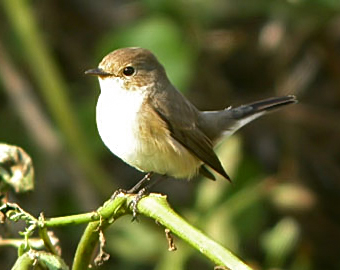
Red-throated Flycatcher: South Korea, April 2003
Male albicilla (April 2003). Note the all-dark, rather heavy-looking bill, the powerful legs and the "strong" facial expression considered rather typical of this taxon.
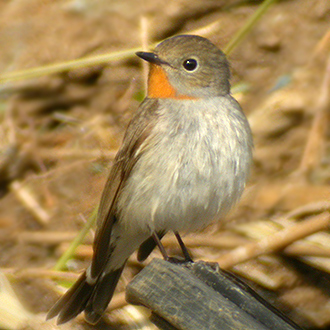
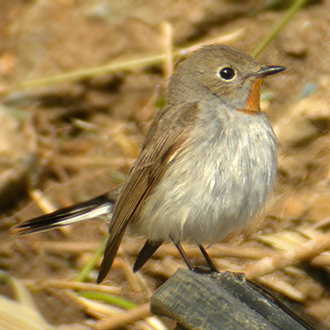
Thanks also to Magnus Robb and Atle Ivar Olsen, and to Martin Cade (Warden of Portland Bird Observatory).



